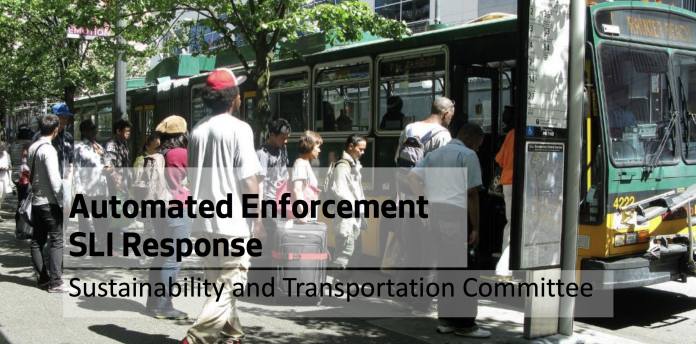Traffic violations are common problems in a city as busy and dense as Seattle. Motorists are notorious for regularly blocking intersections (referred to “blocking the box”) and driving in transit-only lanes. These traffic violations have significant impacts by delaying transit, increasing congestion, endangering people on foot and bike, and slowing emergency response times. On Tuesday, the Seattle Department of Transportation (SDOT) and Seattle Police Department (SPD) briefed city councilmembers on automated camera enforcement tools that could reduce these violations.
Last January, SDOT conducted a field survey to determine how often “block the box” and transit-only lane violations occur at a select location. The transportation department decided to observe Battery Street, roughly from Fourth Avenue to Third Avenue. While the number of “block the box” violations averaged six per day, the average number of transit-only lane violations reached a shocking 316 per day, suggesting that people feel less comfortable being shamed by crossing motorists than they are by stuck buses and trains behind. SDOT also reported on violation highs, which reached 53 “block the box” violations and 418 transit-only lane violations in a single day.
Mark Bandy, Director of SDOT’s Transportation Operations Division, brought attention to the fact that the violations on Battery Street are right in front of Fire Station 2, the busiest station in the city for emergency calls. He said that violations often lead to obstructions for emergency personnel trying to leave the station, making a clear connection of transit-only lanes serving multiple purposes.
Stephen Hirjack, Assistant Chief of SPD’s Special Operations Bureau, explained why his department is challenged with manual enforcement.
“There are a lot of logistical issues with police enforcement of this–a question I field frequently is ‘why aren’t we writing more tickets for this type of thing?’,” Hirjack said. “There’s actually obviously the physical limitation of resources we have of officers being at all these different places for prolonged periods of time. But the more practical implication is that when an officer pulls someone over in one of these lanes, we’ve now blocked that lane, which is exactly the behavior we don’t want in the first place.”
Hirjack further highlighted that blocking lanes can have a direct impact in increasing congestion and delay as well as safety implications to the officer and others.
Under state law, automated camera enforcement of transit-only lanes is not currently permissible. Instead, an officer has to witness the violation in person as a “moving violation”. This is different from school zone speed, railroad crossing, and red light violations, which can be treated as an infraction–similar to a parking ticket–and controlled through automated camera enforcement. When tickets are issued as an infraction, vehicle owners are issued the ticket whether or not they committed the violation personally.
Quinn Majeski, Government Relations and Policy Analyst for SDOT, said that the city is actively working to obtain authority from the state to implement camera enforcement for transit-only lanes. The city is focusing on getting authority to install cameras not just at intersections, but also at mid-block locations which are critical to transit. Privacy of motorists would be maintained, meaning that the faces of drivers and passengers would not be captured in photographs.
Last year, a bill sponsored by Representative Joe Fitzgibbon (D-Seattle) in state legislature made it of out committee, but never ended up getting a floor vote. Representative Fitzgibbon has indicated that he plans to revive the bill this year. Joining the city in lobbying for the new authority, Transportation Choices Coalition has made it a top legislative priority.
According to several case studies that SDOT reviewed, automated camera enforcement put a big dent in violation and congestion reduction in addition to increasing safety and transit speeds.
Boston partnered with Waze to address “block the box” and double parking violations. That effort reduced congestion by 18% and travel delays by 20%. San Francisco instituted a pilot program for transit-only lane cameras, which pushed violations down by 55% and reduced collisions by 16%. In London, transit lane cameras have been in operation since 1997. SDOT cited a report from 2007 indicating that those cameras managed to increase transit speeds by 5%, saving passengers valuable time and transit agencies valuable service hours.
Aside from getting state authority to use automated camera enforcement for “block the box” and transit-only lanes, the city would need to update city laws to reflect state statute.

SDOT has identified five key locations that would be desirable for early implementation of automated camera enforcement, including the intersections of:
- Fairview Ave N and Valley Street;
- Dexter Ave N and Mercer Street;
- Denny Way and Westlake Avenue;
- Battery Street and Fourth Avenue; and
- S Jackson St and 4th Ave S.
Three of the locations on would benefit the streetcar lines while all five locations would benefit buses. All of the locations are concentrated near the city center, but these are not the only locations that SDOT is interested in targeting.
If the city is successful at obtaining additional state authority for automated camera enforcement, SDOT estimates that each camera will costs about $10,000 to install based upon the 2014 school zone program. Most locations will require two to three cameras to adequately enforce against violations. In the city’s experience, the existing automated camera enforcement programs are more than self-sustaining through fines. So there is little reason to think that expansion would not be.
Stephen is a professional urban planner in Puget Sound with a passion for sustainable, livable, and diverse cities. He is especially interested in how policies, regulations, and programs can promote positive outcomes for communities. With stints in great cities like Bellingham and Cork, Stephen currently lives in Seattle. He primarily covers land use and transportation issues and has been with The Urbanist since 2014.



